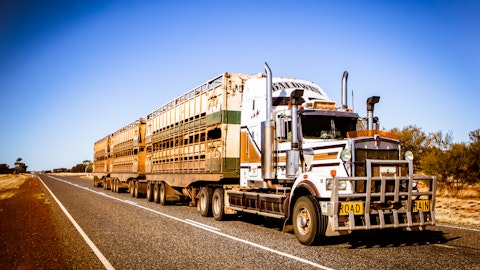Wabash National Corporation (NYSE:WNC) Q3 2023 Earnings Call Transcript October 25, 2023
Wabash National Corporation beats earnings expectations. Reported EPS is $1.16, expectations were $0.97.
Operator: Good day. My name is Rob, and I will be your conference operator today. At this time, I would like to welcome everyone to the Wabash Third Quarter 2023 Earnings Conference Call. All lines have been placed on mute to prevent any background noise. After the speakers’ remarks, there will be a question-and-answer session. [Operator Instructions] Thank you. Ryan Reed, Senior Director of Investor Relations and Corporate Development, you may begin your conference.
Ryan Reed: Thank you, and good morning, everyone. We appreciate you joining us on this call. With me today are Brent Yeagy, President and Chief Executive Officer; and Mike Pettit, Chief Financial Officer. Before we get started, please note this call is being recorded. I’d also like to point out that our earnings release, the slide presentation supplementing today’s call and any non-GAAP reconciliations are available at ir.onewabash.com. Please refer to slide 2 in our earnings deck for the company’s Safe Harbor disclosure addressing forward-looking statements. I hand it off now to Brent.

A line of rental trucks, trailers and portable units parked at a self-storage facility. Editorial photo for a financial news article. 8k. –ar 16:9
Brent Yeagy: Thank you, Ryan. Good morning, everyone, and thanks for joining us today. I’m pleased to announce another quarter of strong financial results, which continues to demonstrate successful execution against our strategic vision. With the industry’s broadest portfolio of first to final mile product solutions and a growing parts and services offering that complements our transportation equipment group, we remain dedicated to elevating our value proposition even further for our partners. In addition to securing two pivotal agreements with strategic customers, we have also focused on adding value across our partner ecosystem by executing relational agreements with key suppliers like Hydro, Ryerson, and most recently, Rockland Flooring.
Rockland is a longstanding supplier of wood flooring for trailers, and their supply commitment will bolster Wabash’s strategic positioning as we look to enhance demand planning within our dynamic industry. Just as we continue in our pursuit of enhanced value creation within our transportation solutions business by redefining relationships with our evolving set of direct customers and key suppliers, we have similar strategic focus on amplifying our parts and services offering by working collaboratively with our best-in-class dealer network to provide differentiated offerings to make customers more efficient by leveraging our parts distribution capabilities as well as embracing the power of digital transformation. I’m excited to announce a significant expansion of our Wabash parts network and trailers as a service capabilities to a new joint venture with Fernweh Group.
The collaboration is strategically aimed to enhancing our e-commerce and partner ecosystem. Fernweh boasts a distinguished track record in scaling industrial tech, and we anticipated this JV will significantly accelerate our development and growth of an end-to-end digital platform that provides an industry-leading experience to our dealers, traditional and non-traditional suppliers of both parts and services, and a broad set of customers spanning the transportation, logistics, and distribution landscape. Wabash is positioned as a central figure with an increasingly complex ecosystem of industry participants where innovation endeavors to address challenges within transportation, and we look forward to using our unique positioning to work closely with Fernweh to scale transformative projects that will help to enhance efficiency of logistics networks.
I would also like to take a moment to thank our Board of Directors whose active engagement and diligent oversight throughout the process of forming the strategic joint venture has been instrumental. As always, their collective experience, guidance and support has been pivotal in steering us along this path of reinvigorated organic growth. If this joint venture appears to be a departure from a well-worn path for Wabash, I would respectfully encourage you to take a closer look at our most recent journey. Over the past few years, our company has learned on a profound transformation. We’ve restructured, resegmented, rebranded, refinanced our debt and recapitalize our manufacturing operations. These sweeping changes have yielded substantial financial accomplishments that have come ahead of schedule.
At our 2022 investor meeting, we unveiled a new set of long-term financial targets, which included an EPS goal of $3.50 per share by 2025, which at the time was viewed as an ambitious target. For those keeping score home, we have achieved $3.74 of EPS through the first three quarters of 2023 are in the process of setting a new bar for what peak earnings can look like for this company. And just as importantly, as demand conditions within Van soften in 2024, we fully expect to put in our best trough performance as the power of our portfolio shines through with truck bodies, Van trailers and parts and services all expected to continue posting strong financial performance. While I called this out in the past, I’d like to reiterate that the record earnings figure we will achieve in 2023 and is being done so on unit volume that resides meaningfully below full factory utilization.
Additionally, by the time we make our way back to the next market peak, we would expect our parts and service business to be in a margin-accretive piece of the portfolio. Turning our attention to market conditions and backlog, shipment activity continued to outpace new orders in the third quarter which is not surprising given the softening of demand conditions as freight rates pump along the specific bottom [ph]. Considering the challenging transportation market conditions that our customers have been intending with, it’s also not surprising to see order activity shifting towards the later stages of the typical seasonality time frame. Ending Q3, our total backlog stood at $1.9 billion, while our 12-month backlog was $1.4 billion, and we do expect to achieve an uptick in order flow through Q4 with order season now underway.
As industry participants have noted every additional month that the freight market continues to languish, the stronger and more durable, we expect the inevitable recovery to be. Over the long term, we maintain our belief that our core markets are benefiting from secular trends such as power only, persisted driver shortages and resurgence of restoring activity within North America. Moving on to our financial outlook. With the first three quarters of EPS in 2023 outstripping mini pool year in the company’s history. We again are pleased to raise the midpoint of our full year 2023 EPS guidance to $4.65 from $4.45. In closing, we are well prepared to execute in 2024. Wabash is as strong as it’s ever been at this point in the freight cycle, with minimal leverage and the ability to continue our focused execution on our unique organic growth projects outlined on our strategic road map.
We expect to navigate a reduction in dry van industry demand next year, but we will do so with recently proven capabilities and with the performance of other major facets of the business remaining strong in the coming year that will allow us to accelerate as demand rebounds within the van segment during 2025. We see 2024 as a point in time where we will expand and deepen relationships with our dealers, suppliers and customers as well as interesting new players within the transportation, logistics and distribution landscape. Yes, certain markets may pull back in 2024, but nothing is happening that will derail us from our purpose and our strategic mission. We are executing to the plan that improves our financial performance at all points in the cycle, and facilitates opportunities for Wabash to continue to grow our level of value creation for all stakeholders.
With that, I’ll hand it over to Mike for his comments.
Mike Pettit: Thanks, Brent. Beginning with a review of our quarterly financial results. In the third quarter, our consolidated revenue was $633 million. During the quarter, we shipped approximately 10,765 new trailers and 4,160 truck bodies. Given what we see in the market environment for vans, we made the decision to take some targeted downtime at our main trailer facility. This accounted for new trailer shipments coming in slightly below what we might have expected one quarter ago. In doing this, we have maintained the vast majority of our full-time production employees in order to preserve our flexibility to respond to near-term demand changes. Gross margin was 19.4% of sales during the quarter, while operating margin came in at 12.3%.
These figures remained strong due to a combination of favorable factors, including material cost and mix benefits as truck bodies, tank trailers and parts and services remain bright spots in our portfolio. In the third quarter, we achieved strong operating EBITDA of $93 million or 14.8% of sales. Finally, for the quarter, net income attributable to common stockholders was $55.3 million or $1.16 per diluted share. From a segment perspective, Transportation Solutions generated revenue of $583 million and operating income of $89 million. Parts and services generated revenue of $56 million and operating income of $12.4 million. Our parts and service segment grew again in excess of 20% during the quarter, and our partnership with FreightVana increases our confidence in the future revenue potential for this business.
Looking forward to next year, we expect parts and services to continue growing at a 20% clip. Year-to-date operating cash flow was $205 million, reflecting our strong financial performance. Even in the context of significant growth investment via capital expenditure of $30 million, the company generated $28 million of free cash flow during the quarter. Concerning our balance sheet, our liquidity, which comprises both cash and available borrowings was $447 million as of September 30th. We finished Q3 with a net debt leverage ratio of 0.8 times. This is our lowest leverage ratio since 2017, and I’d also like to note that Wabash’s debt rating was upgraded during the third quarter by S&P. Given the current interest rate environment, we are very pleased with our debt structure, which is simple.
Consisting of one issuance of $400 million in principal value and also cheap in today’s environment with a rate of 4.5%. These notes mature in late 2028, and we currently see no reason for debt repayment to be part of our capital allocation priorities. On the topic of capital allocation, during the third quarter, we invested $29 million in capital projects and $1 million in revenue generating assets for our trailers as a service platform. We utilized $18 million to repurchase shares and paid quarterly dividends of $3.8 million. Our capital allocation focus continues to prioritize capital expenditure above and beyond our annual CapEx maintenance spend of $20 million to $25 million in order to support our organic growth initiatives. We are committed to maintaining our dividend and then we anticipate continuing to evaluate opportunities for share repurchase alongside a bolt-on M&A.
Moving on to our outlook for 2023. Our financial outlook now contemplates revenue of approximately $2.6 billion, and we are increasing our outlook for EPS by $0.20 per share at the midpoint to $4.65 per share with a range of $4.60 to $4.70 per share. This compares to the previous EPS outlook midpoint of $4.45 per share. We continue to expect $150 million of free cash flow during 2023 in a year where we have meaningfully recapitalized the manufacturing of a flagship drive-in product line as well as providing additional capacity for future growth. We’ve also invested in important growth initiatives such as cold chain and returning revenue. In our financial outlook, we expect fourth quarter earnings per share in the range of $0.86 per share to $0.96 per share.
While we’re still in the process of gathering all the necessary inputs to provide precise 2024 guidance, I would like to share some insights that I hope are helpful in thinking about the outlook for next year. First, as Brent mentioned, the cadence of order season for vans this year is much more similar to the calendarization of many pre-COVID years. We were fortunate in 2020, 2021 and 2022 that demand conditions were exceedingly strong so as to pull order season forward in those years. 2023 resembles something more usual from a historical perspective. Our negotiations with customers have been productive and we expect to actively close orders for 2024 during the fourth quarter. What we’ve seen so far aligns with industry forecasters in that demand seems poised for a modest pullback to a level that most would consider mid-cycle territory.
Now that commentary is specific to vans. With regard to our other businesses, we expect to see continued strength within areas like truck bodies, tank trailers and parts and services. Together, these segments are poised to contribute significantly with the potential to generate around $200 million of gross profit in 2024. To be clear, that figure excludes the contribution from dry vans, and it alone surpasses our consolidated gross profit performance in years like 2020 and 2021, reflecting the robust potential within truck bodies, tank trailers and parts and services. In conclusion, I’m thrilled to check off a meaningful long-term financial target more than two years ahead of schedule. I’m also pleased to be able to raise our full year guidance again this year, but even more excited about what our 2023 financial performance signals for years to come.
We have a very strong and capable team that has generated our record 2023 performance, and we believe we’re still in the early innings of realizing the full capability of our remade company. Perhaps surprisingly, I’m also enthusiastic about our prospects for 2024. For over three years, we’ve been exploring the potential of our first to final model, One Wabash plan, designed to transform the company’s cyclicality. As we look ahead to 2024, we’re poised to showcase the continued progress we’ve achieved in stabilizing Wabash’s historical earnings volatility. Wabash occupies a prominent position as an industry leader in transportation equipment and is positioned at the center of an increasing and complex ecosystem of participants within transportation, logistics and distribution.
We’re actively collaborating with Firmway to bring value to this ecosystem by crafting a digital marketplace capable of uniting these diverse stakeholders to address industry challenges. We firmly believe that this initiative will define the next chapter in our journey to change how the world reaches you. It’s an exciting time and we’re eager to continue shaping the future of the industry alongside our partners and stakeholders. I’ll now turn the call back to the operator and we’ll open it up for questions.
See also 20 Highest Paying Countries for Doctors and 12 Defensive Healthcare Dividend Stocks To Invest In.
Q&A Session
Follow Wabash National Corp (NYSE:WNC)
Follow Wabash National Corp (NYSE:WNC)
Operator: [Operator Instructions] And your first question comes from a line of Justin Long from Stephens. Your line is open.
Justin Long: Thanks, and good morning.
Brent Yeagy: Morning.
Mike Pettit: Morning, Justin.
Justin Long: So maybe to start, I was wondering if you could help us understand the positive impact you saw from material margin in the third quarter? And then as we move into fourth quarter and early next year, how you see that progressing?
Brent Yeagy: Yeah. We did see some positive sourcing-related material cost impact in Q3, call it, non-commodity related that some of that will continue into Q4, some will not. And that was a partial driver to our fee versus our original guide. So I would expect a little bit of a step down into Q4 in our material margin, which is embedded in our guidance. But not a ton. So we would expect to maintain some of that bursting benefits of the gap, but you will see a little bit of a step down from the material margin perspective.
Justin Long: Okay. And would you expect that to normalize in the first and second quarter next year? And what point will we get to kind of a more normalized manufacturing margin level?
Brent Yeagy: Yes, Q4 will be a, I would say a, much closer to what we’d expect to see in 2024 from a margin perspective, but we obviously still have a lot of work to do from a backlog fill perspective before we can give any official guidance. So we didn’t give guidance for 2024 yet. So I can’t say that will be the exact margin profile, but Q4 will be closer to what we’d expect to see in a run rate level.
Justin Long: Okay. Understood. And maybe following up on what you just said, you gave some helpful puts and takes for 2024 and totally under I appreciate that the macro environment makes forecasting challenging, but how are you thinking about the range of potential outcomes for the business in 2024? And maybe you could speak to how you’re managing resources based on that range. I heard you say at one point, you took some targeted downtime at one of your facilities in the third quarter. But just curious if you could comment on the range for 2024, if you have any thoughts there and how you manage resources to that range?
Mike Pettit: Yes. Absolutely. I’ll start and then I’ll let Brent maybe take the resource part of the other question. But we clearly believe that we’re going to see some nice order inflow in Q4, which is not uncommon, and we — in some of the prepared remarks, we mentioned that —- if you go to the pre-COVID days being the majority of their backlog fill going into year end and Q4 was not a – not an normal thing. And we’re getting back to that calendarization of order fill. We feel pretty good about what we can deliver in Q4 and going into 2024. And also, that’s very much a driving specific comment. As I mentioned, we have a lot of other revenue streams that we feel are filling will provide a lot of support in 2024. And those are the parts in tank trailer and truck we talked about.
So it’s a wide range, which is why we didn’t give a formal guidance, but we would expect to see any reduction that happens from the trailer orders that you’re seeing from ACC FCR, we would expect we would not see that big of a drop in revenue, for sure, based on some of the support we have in our other value streams, and we’ll have a lot more color and context around what we’ll see from dry vans at the year end call. Brent?
Brent Yeagy: Yes. So Justin, when you think about it from just a, I think, you’re primarily talking about hourly headcount, [indiscernible] structure and so on. I think the way that we see it is that we’ve got to look at Q3 and Q4 of 2023 to bridge the entire story. We specifically are managing this current period of time to position our overall headcount to support how we see the first half of 2024 playing out and making sure that we’re in a great position to react to an increase in demand as we go into the tail end of 2024 and absolutely into 2025. So what does that actually mean? What that means is, specifically for our dry van operation, we believe we can stay solidly on two-shift operation throughout the year with the ability of using overtime to flex with would we say opportunistic changes in demand in the early part of the year and give us a nice solid baseline that we can grow and prepare for 2025 in the second half of the year.
We think the market has the potential to be able to do that, even with the clarity issues we have today. To Mike’s point on the rest of the business, specifically tanks, truck bodies, and parts, we’re actually in a position where we are maintaining, if not growing, headcount in those aspects of the business in 2024 to meet the known market drivers and demand that we have on the table today. So we are still, what I would say, net-net, in a great position in terms of how we think about having an active and robust resource management outlook going into 2024.
Justin Long: Okay. Very helpful. Thanks for the time.
Brent Yeagy: Thanks Justin.
Mike Pettit: Thanks Justin.
Operator: Your next question comes from the line of Mike Shlisky from D.A. Davidson. Your line is open.
Mike Shlisky: Hello. And thanks for taking my question.
Brent Yeagy: Yeah.
Mike Shlisky: Can we start off — there’s one topic I didn’t mention for 2024 and that was the Reefer business. I know that’s in a bit of a transition at the moment. Can you update us on the transition to Minnesota for that business and decades of how that might ramp up next year and/or in 2025?
Brent Yeagy: Yeah. So when we think about our cold chain product lineup, Mike we want to make sure we talk about it in the total lineup, not just on Reefer Vans. We’re going to be in a nice place in 2024, where we think we can actually be additive, in the total amount of cold chain revenue and overall product output in 2024. That’s a combination of a relative amount of maintaining, if not slightly growing on our EcoNex reefer van, but also pulling through additional parts and service revenue and we are now seeing an opportunity with EcoNex medium-duty truck bodies that we’ve been able to establish a foothold in, in 2023. That’s an area of potential expansion for us in 2024.
Mike Shlisky: Got it. And then just taking a step back on 2024, it sounds like you’re already calling that trough. And I guess I’d like to know your confidence that, that 2024 will, in fact, just be a single year downturn, a similar year trough. Is there anything about 2025 should be thinking out about the regulations or just where you think of reaching currently that makes you feel like it will just be a single year?





